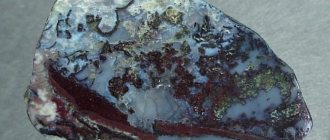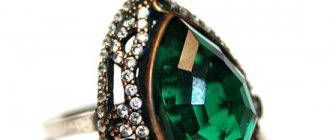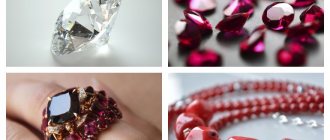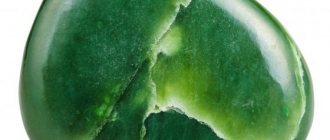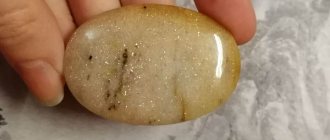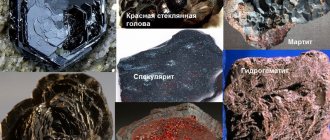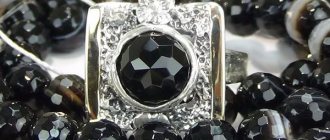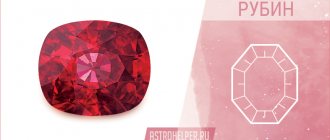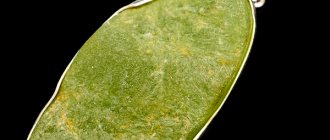| Category | Silicate minerals |
| Title in English | Olivine |
| Formula | (Mg,Fe)2[SiO4] |
| Group | Group of island silicates |
| Color | Pale shades of green |
| Stroke color | White |
| Shine | Glass |
| Transparency | Transparent |
| singonia | Rhombic |
| Hardness | 6,5 — 7 |
| Cleavage | Average |
| Density, g/cm³ | 3,27 — 3,37 |
| Kink | Conchoidal |
| origin of name | The term “olivine” was coined by a German geologist named Abraham Werner. This is how he designated the green inclusions that he noticed in basalts. When this mineral was found, it was decided to give it the name olivine for its beautiful olive color. |
Olivine stone is a member of the family of silicon-containing minerals. By chemical nature, it belongs to quartz containing an admixture of magnesium and iron. Moreover, its properties are absolutely similar to two other stones: chrysolite and peridot. This is due to the fact that in Germany Werner called the transparent green stone “olivine”, and in France it was already known as “peridot”, and in Greece as “peridot”. Today, many other names are known for the stone, but in mineralogy it is generally accepted that the main one is olivine.
Olivine deposits
— Advertising —
The first deposits of olivine were discovered on St. John's Island (Red Sea) in the 4th millennium BC. Today, these deposits are almost completely depleted and exhausted.
The largest modern deposits of olivine were found in the United States, in Arizona and New Mexico. It is also found in countries such as Brazil, Australia, Kenya, Norway, Mexico, Hawaii, Egypt and Russia. Colorless crystals are mined on the island of Sri Lanka. Indian high quality olivine is also known as Kashmir Peridot. Large samples, weighing about 200 carats, are mined in Myanmar.
Place of Birth
Olivine is one of the main rock-forming minerals, so its deposits can be found everywhere. In Russia, there are large deposits in Buryatia, the Krasnoyarsk Territory, Yakutia, the Amur Region and the Kola Peninsula.
The largest deposits are located in the USA, India, Mexico, Norway, Australia, and Kenya.
It is also mined in Afghanistan, Italy and many other countries. Tourists visiting the Canary Islands are sure to buy olivine beads.
History of olivine
The name of the mineral olivine is associated with the similarity of its color to the color of the fruits of olive trees.
It was invented by the French mineralogist Alfred Werner. In those days, the gem was considered a subspecies of chrysolite, but then everything changed, and according to modern ideas, chrysolites are a light variety of olivine. There is a mineral under another name “peridot”. Olivine has been known to mankind relatively recently, but has become widespread in the manufacture of amulets and amulets as a mineral with strong magical properties.
Other olivine beaches
There are several other green olivine beaches on the planet. One is located on the island of Guam in the western Pacific Ocean, in Micronesia. The island is part of the Mariana archipelago, famous for the fact that in the ocean next to it there is the deepest hole in the earth's crust - the Mariana Trench (11 km).
Here, green olivine, born in the volcano, is adjacent to dazzling white and orange sand from coral chips.
The Galapagos Islands, which belong to Ecuador, boast green beaches. The archipelago is located in the Pacific Ocean, a thousand kilometers from the coast of South America. The islands have active volcanoes that regularly supply olivine.
There is such an exotic beach in Europe, but there are few swimmers there. After all, the olivine beach is located in Norway, and is washed by the waves of the cold North Sea.
Physicochemical characteristics of olivine
— Advertising —
By chemical nature, olivine is an orthosilicate of magnesium and iron. Its crystals of prismatic or pyramidal shape are rare; granular masses are more common. Olivines are very fragile. Hardness on the Mohs scale 6.5-7. Density 3.27-3.37 g/cm3. The surface of the stone is easy to scratch, and sulfuric acid completely destroys it with the formation of a gelatinous mass.
There are both colorless specimens and black, yellowish-green, olive and bottle green. They have a glassy luster and rhombic structure. There is no cleavage.
The characteristic distinguishing features of olivine are its non-metallic luster, olive-green color, and content in dark rocks of igneous origin. When olivine breaks down, serpentine (serpentine) is formed.
Chemical formula of olivine. Physical and chemical properties of this mineral.
The mineral Olivine is described by the chemical formula (Mg,Fe)2[SiO4]
But, despite the composition of the formula, it can change, “sprouting” with all sorts of impurities presented in the table below. The ratio of impurities to the main composition of Olivine has a direct impact on the natural color of the mineral, the intensity of which depends on how deeply the impurity has penetrated into its base. It is impossible to say that olivine has an exact color that is unique to it. The color within the crystal itself may be unevenly distributed.
If olivine contains a lot of nickel and chromium, its color will be rich, bright green. This type of olivine is the most common.
The darkest color is found in olivine of the ferruginous variety - fayalite.
| Properties | Description |
| Mineral shine | transparent glass. |
| Mineral hardness | from 6 to 8 |
| Density | on average 3.8 g/cm3 |
| When heating | Olivine is known for its viscosity, but is not at all sensitive to extreme heat. |
| Type of mineral | oxygen compound |
| Mineral class | silicates together with analogues |
| Subclass of mineral | island structure |
| singonia | rhombic, pronounced |
| Fragility | significantly increased |
| Occurs in nature | in the form of a mass of rounded grains of different sizes (nuggets and sand), similar to gold. The line is always white in color |
| Color shades of classic olivine | light yellow, then to yellow, olive, olive green, bottle green, blue-gray, gray, brown and at the end of the color series - rich black. Less commonly, it is white, reddish-brown and dark burgundy. |
| Possible impurities | quartz and iron, chromium and nickel, magnesium and manganese |
If olivine is exposed to a hot aqueous solution, it is converted to talc or serpentine. This process has its own name - serpentization.
During weathering, all the minerals that make up the olivine group turn into one of the derivatives of naturally occurring stones - opal, nontronite, limonite, pyrolusite, garnierite, brucite, magnesite.
The main synonyms of olivine are peridot and chrysolite. Moreover, chrysolite is considered to be natural olivines from transparent yellow-green to deep green. It is chrysolite, in the form of a variety of olivine, that is truly a precious stone. Moreover, the name of this stone, “peridot,” is much more common than “olivine.” Especially in scientific literature.
An example of some of the main minerals that make up the olivine group with a chemical formula describing each of them.
- Calcium-olivine - Ca2SiO4
- Fayalite – Fe22SiO4
- Forsterite - Mg2SiO4
- Glaucochroite – CaMn2SiO4
- Kirsteinite – CaFe2SiO4
- Liebenbergite - (NiMg)2SiO4
- Monticellite - CaMgSiO4
- Rupperite – Fe22MnZnSiO4
Types of olivine
The most valuable subspecies of olivine, which is widely used in jewelry, is chrysolite. The color of its transparent crystals varies from yellow-green to emerald green and dark olive. There are also pistachio and yellow specimens. It all depends on the content of impurities in each specific sample.
Another variety of olivine is the mineral Hawaiiite, which is a pale green, low-iron olivine that is mined from lava in the Hawaiian Islands.
Silicates of the olivine group also include forsterites, fayalites, knebelites, and tephroites.
Varieties
Olivine is a mineral that has many varieties, representing a whole family of minerals that differ in composition and color.
If it lacks iron, it is a magnesium silicate called forsterite Mg2SiO4. It comes in white, grey, pale yellow or green. It has the lowest density among olivines -3.275 g/cm3 and the highest hardness -7.
If there is no magnesium in olivine, then it is an iron silicate called fayalite Fe2SiO4. Its color can be brown, yellow and black, and its density is noticeably higher than that of other olivines - 4.39 g/cm3, and its hardness, on the contrary, is less than -6.5.
These two minerals are extreme members of the isomorphic forsterite-fayalite series.
Magnesium in forsterite can be replaced by calcium, and a continuous isomorphic series of forsterite-calcio-olivine Ca2SiO4 is also formed. The middle member of the CaMgSiO4 series has its own name monticellite.
If calcium in olivine is completely replaced by calcium, then such a mineral is called kirnsteinite (CaFe)2[SiO4].
Iron in it can also be replaced by manganese, resulting in glaucochroite (CaMn)2[SiO4].
When iron in olivine is completely replaced by nickel, libenbergite (NiMg)2[SiO4] is obtained.
Finally, there is the olivine mineral, which contains zinc. This is rupperite (FeMnZn)[SiO4].
Transparent, gem-quality olivine with a color ranging from greenish-yellow to emerald green is called peridot. This is what the Egyptians valued so much 5000 years ago.
Serpentine or serpentine ornamental stone is also olivine that has been exposed to water. It belongs to the group of magnesium-iron hydrosilicates, numbering about 20 minerals that have their own names.
The magical properties of olivine
Olivine is the patron saint of both strong-willed and weak people.
It protects from unpleasant situations and leads its owner onto the path of good luck and success, while showing him the right, correct path. Since ancient times, the gem has been considered a source of secret knowledge, thanks to which its owner can successfully implement all his ideas, even those that had previously led to failure.
For people who desire to gain fame and fortune, olivine will also be a good helper. Along with fame and money, the stone will also give the owner morality and wisdom, the ability to achieve what he wants by following an honest path.
Olivine also helps in family problems. It strengthens family ties, eliminates conflicts, quarrels, and protects the home from the envy and anger of others. It is also believed that it prevents fires.
Olivine saves those who are inclined to take risks without thinking about their actions for a long time. At the same time, a person begins to avoid rash actions and gains wisdom.
Olivine belt
At the beginning of the last century, geophysics armed itself with sensitive instruments that detect the movements of the earth's crust deep in the bowels of the planet.
Having studied these fluctuations, scientists came to the conclusion that a huge ocean of viscous and liquid matter boils under the rocky surface of the Earth. No drilling machine can reach that deep yet. But it is still possible to study the contents of the underground “cauldron”. This substance - magma - is helpfully delivered to the surface by volcanoes.
According to geologists of the 20s of the last century, the Olivine Belt, consisting of a molten mix of minerals and metals, seethes several tens of kilometers under our feet. Olivine and gold predominate in this hellish mixture.
Writer Alexei Tolstoy used the Olivine Belt theory in the famous adventure novel “Engineer Garin’s Hyperboloid” (1927), where inventor-adventurer Pyotr Petrovich Garin pierces the earth’s crust with a ray of a fantastic hyperboloid, and becomes the richest man in the world.
A hundred years have passed, and geophysicists have a much clearer understanding of the structure of the Earth's internal structure. Now Tolstoy would hardly have enriched literature with his wonderful novel. Modern geophysicists have proven that there is no molten gold in the Olivine Belt. This heavy metal should sink well below the light olivine melt.
Medicinal properties of olivine
The range of healing properties of olivine is very wide and includes the following areas:
- normalization of the nervous system;
- treatment of heart and vascular diseases;
- gynecological diseases, as well as childbirth - to relieve pain and ease contractions;
- in case of metabolic disorders to stabilize it;
- for healing wounds quickly;
- to enhance male potency;
- for headaches and migraines;
- to normalize sleep and get rid of nightmares;
- after strokes for faster recovery;
- to stabilize the condition of patients with multiple sclerosis;
- to normalize a person’s psychological state, reduce anger, aggression, jealousy, indignation, hysteria.
Olivine is very popular in the treatment of vision. To do this, they look at the mineral for a long time and their vision becomes better.
It is recommended for newborns to hang an olivine amulet around their neck to protect them from illness and negative energy.
In folk medicine, it is advised to place the mineral next to the diseased organ for a while.
Olivine, which is used for medicinal purposes, is important to regularly cleanse of the negative energy that it absorbs along with diseases.
Olivine in lithotherapy
Good for the stomach
It is believed that the mineral has a beneficial effect on the digestive system and helps relieve inflammatory processes in the stomach and gall bladder.
The gem can help with diseases of the cardiovascular, central and peripheral nervous systems, strengthens the heart and memory. It has long been recommended to look deep into a transparent stone to improve visual acuity.
Liquids in which this mineral has been present acquire healing powers. Lithotherapists recommend drinking a daily infusion for a week, 1 glass per day, before bed. After a week's break, you can repeat the course until recovery.
Applications of olivine
In jewelry, olivine is known as peridot or peridot and is very popular. This is due to the exquisite noble shine, golden-green color of the stone, and its ability to refract light. Thanks to all these qualities, jewelry with olivines is very, very beautiful. They are used to make earrings, brooches, necklaces, rings, and hairpins. Unfortunately, due to low wear resistance, jewelry with olivine is rare and is quite expensive.
Areas of use
Rock with a low percentage of iron is used in metallurgy in the manufacture of refractory bricks for the construction of blast furnaces, open-hearth furnaces and accessories for them, and with a higher proportion of magnesium it is used for the production of technical glass and special viscous grades of cement.
The main use of olivine is jewelry.
Olivine colors
The color of olivine is determined by the concentration of impurities in it, namely the content of nickel and chromium. In addition to all shades of green, there are black and colorless samples. And the most valuable are considered to be olivines with uneven coloring, in which the golden-green color smoothly flows into greenish-brown or turquoise.
What does the Earth rest on?
But in other respects, Alexei Tolstoy was not mistaken. Olivine is indeed a common mineral. It composes the igneous rocks of the planet's mantle, on which the earth's firmament rests. Moreover, olivine is the basis or component of many other minerals and even precious stones (more on this in the chapter “Gem forms of olivine”). Therefore, geologists call olivine rock-forming .
The “godfather” of the mineral was the Swedish naturalist, professor at Uppsala University Johann Valerius. In his fundamental work “Mineralogy or description of all kinds of ores and minerals from the earth” (1747), the scientist proposed calling the yellow-green mineral, whose color resembles olives, olivine .
Rocks rich in olivine are a sure sign of deposits of diamonds, platinum, chromium, titanium, and nickel.
But olivine is also found on our planet and is of unearthly origin.
How to care for olivine
Olivine is protected from mechanical stress and stored separately from all other types of stones, in tightly closed boxes, wrapped in soft cloth. To clean products with this gem, you can use warm soapy water, after which they are rinsed under running cool water and thoroughly polished with a soft cloth.
Olivine from Space
Pallas iron has been identified throughout the world. Only in three rare cases was the fall of such an iron-stone meteorite observed. This happened on the island of Sicily (1826) and in Japan (1898). The third fall of pallasite was seen by the Finns in the mentioned region of Marjalahti.
The bulk of the pallasite fragments found belonged to meteorites that crashed onto the surface of our planet in the distant past.
In 1890, meteorite fragments interspersed with olivine were discovered near the town of Brenham (Kansas, USA). In total, more than 20 large fragments were collected, weighing about five tons. One of them, weighing 1,074 pounds (487 kg), is in the Natural History Museum in Chicago.
In 2005, meteorite hunters Steve Arnold and Phil Money explored the same area. Using metal detectors, they discovered and recovered several more large fragments of the meteorite from the ground.
An almost one and a half ton pallasite meteorite was found right on the pasture of a cattle farm near the city of Alice Springs, in northern Australia (1937).
Fragments of a meteorite weighing about a ton total were discovered in the Chilean Atacama Desert (1822).
In 2000, a farmer from the Chinese province of Xinjiang removed a huge boulder from his rice field, which turned out to be pallasite.
While digging a pit in the Gomel region (Belarus) in 2002, they found a fragment of a space guest (227 kg), buried three meters into the ground.
At various times, “Pallas iron” was found in the vast icy expanses of Antarctica.
Olivine and the zodiac sign
Olivine is the patron saint of representatives of the three zodiac signs.
He helps Virgo in acquiring knowledge and wisdom, gives patience, and teaches him to enjoy freedom. It somewhat reduces the natural demandingness and conservatism of this sign, and adds the necessary degree of recklessness. For Pisces, olivine brings confidence and eliminates minor troubles. Teaches endurance and the ability to endure stress.
The gem also helps Leos, as it successfully restrains their internal aggression. At the same time, Leos begin to resolve conflict situations with others peacefully, become softer and more sensitive, while gaining friends and supporters, as well as the sympathy of others.
The magic of olivine
Magicians of the Eastern school have been using olivine for their rituals for thousands of years. The binary magical properties inherent in pallasites (metal-stone) that fell from Space are especially valued.
And terrestrial olivine is filled with energy not only from the underground, but also from the entire Universe. The magical properties of amulets made of cheerful green chrysolite are aimed at good luck in all the owner’s endeavors. It is recommended for those who have experienced a period of chronic failure in business.
How to spot a fake
There are several proven ways to distinguish a fake:
- natural stone heats up slowly in your hands, fake stone heats up very quickly;
- the cut stone needs to be turned in the sun - the ray of light is refracted in two at the real specimen;
- natural olivine is difficult to scratch, but a plastic fake is easy to scratch;
- there are a lot of fakes in Sri Lanka - craftsmen put bottle glass in water with stones and after a while the current makes them hewn, similar to natural gems, but upon closer examination you can notice the uneven coloring of the glass.
A reliable way to determine natural origin is a certificate.
Natural stone is very beautiful, it’s not for nothing that it is compared to emerald. But unlike the latter, the price is much more affordable, which means that almost everyone can afford jewelry with it.
